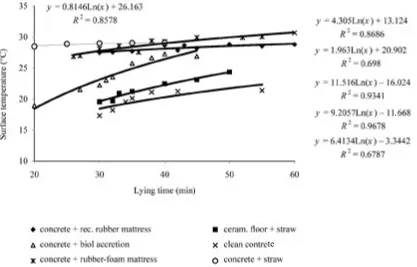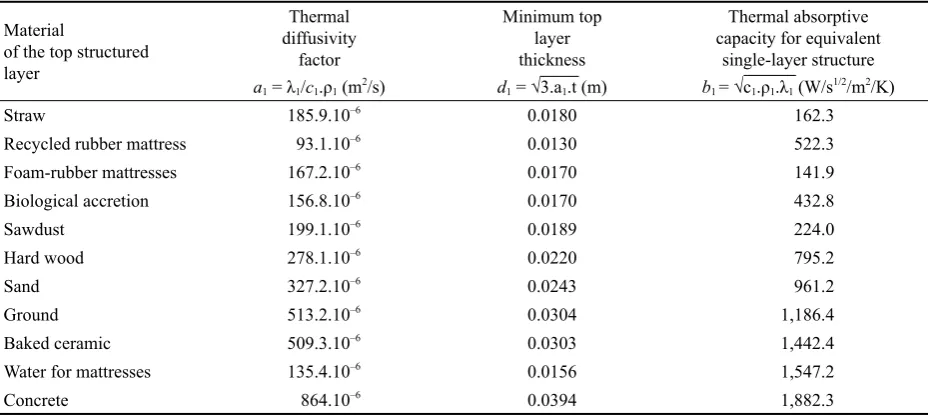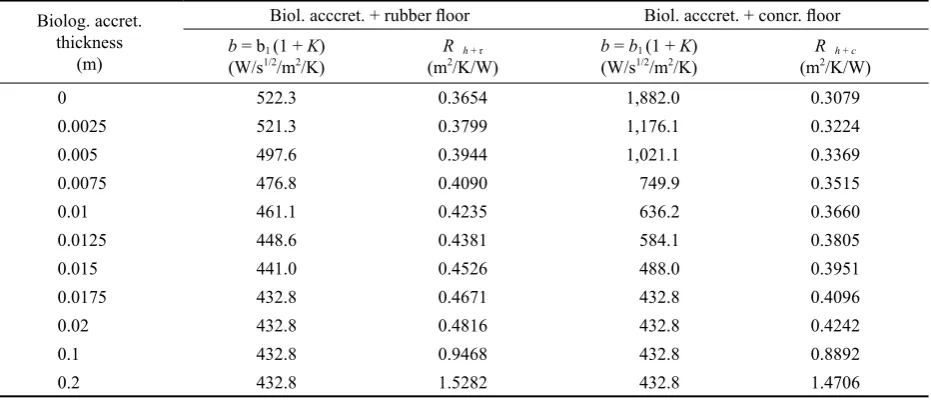A lying longitude and comfort in relaxation has a pri-mary influence on the total dairy cattle productivity. The lying cow is in direct body contact with the floor during a large part of the day (in positive examples it is 12 to 14 hours per day).
An experiment in 1999 described cows laying in cu-bicles on 100 mm thick mattresses, 776 minutes daily, on average, and was the best daily time of all ordinary housing systems in use (BRESTENSKÝ et al. 1999).
Because of milk quality production there is important an undisturbed resting during lying time. Its thermal comfort is one of the factors affecting lying comfort, and that is why we care about the thermal absorptive capacity of selected types of flooring. Winter thermal discomfort of animals is caused by a structured floor type, which results in a small thermal resistance, but especially high thermal absorptive capacity.
An interactive heat results between the floor and the cow’s body as a temperature is measured on the floors surface either by a system of contact thermal sensitive elements or surface temperature measuring, by non-con-tact measuring equipment, directly after the cow leaves the lying cubicle. Contact temperature drops rapidly during the first and second lying minute. The tempera-ture gradient value from 4 to 15°C is dependent on the structure of the floor (POGRAN, LENDELOVÁ 2002).
At that time, the contacting body part, representing approximately 1.36–1.38 m2 in area, behaved as a
phys-ical entity with constant properties. Then the thermo-re-gulation process of the animals body starts, the amount of heat flowing from the body’s surface and the heat taken by the floor, the surface temperature either increa-ses (so-called warm floors) or drops (cold floors). Final-ly the new equilibrium thermal state of the body surface temperature drops to the floor surface temperature level (ŠLAJS, HANUŠ1995).
The floors with low values of thermal absorptive ca-pacity are well accepted by dairy cattle. Contrariwise so called cold floors, with high thermal absorptive capacity values are used for only a short lying time (on concrete floors 2–4 hours daily). Calculating thermal absorpti-ve capacity values is important to assess, how many structured layers will have a demonstrable affect on the thermal absorptive capacity end value, consequently as an equivalent single-layer, double-layer or three-layer floor structure (HALAHYJA et al. 1998).
The aim of this article was to study the floor structu-res of lying cubicles – with a classic natural or modern artificial bedding – in term of thermo-technical proper-ties of multilayer floors and to clarify the effect of floor structure to dairy thermal comfort in the rest time. In new buildings and reconstructions too, it is important to select from generally used floor constructions those which have the smallest thermal absorptive capacity, high vitality and acceptability for dairy cattle. It is the designing way, how to eliminate a wastage of heat-power flow and to increase the lying comfort.
MATERIALS AND METHODS
Five cubicle flooring materials were tested in winter (2. January–31. March 2003) in the experimental farm of Nitra Research Institute of Animal Production and one flooring material (Styropor mattresses) was tested on Zuberec farm.
The barn in Nitra was divided into two spaces, one part with 18 dairy cows, where 18 elevated cubicles consisting of 150 mm concrete and 150 mm gravel were applied. Eight concrete cubicles from them were covered by mattresses filled by recycled rubber, seven concrete cubicles without mattresses were covered with adjusted dry biological coat thickness of about 20 mm.
Thermo-technical properties of floor structures for lying
cubicles
J. L
ENDELOVÁ, Š. P
OGRANSlovak University of Agriculture, Nitra, Slovak Republic
ABSTRACT: A paper dealing with prevailing floor construction types from a thermo-technical point of view. The accent was put on lying cubicles for cows, the floors must be soft, dry, warm and flexible. Attention was paid to analysis of the thermal resistan-ce and thermal absorptive capacity of selected types of flooring. The greatest thermal comfort depends upon the design of floor structured coating materials.A biological floor accretion layer has a positive thermal influence and softens thermal comfort during the animals lying period. A calculation, estimating values of thermal absorptive capacity, shows that the quality and thickness of the structured layer on a covered floor is very important, underlying layers are only affected with thinner designs of a calculated boundary value.
146 RES. AGR. ENG., 49, 2003 (4): 146–150 RES. AGR. ENG., 49, 2003 (4): 146–150 147
There were three concrete cubicles with excrements completely removed and carefully cleaned. The second part of the barn was created of concrete elevated cu-bicles covered with 65 mm earthenware tiled floor and straw bedding 1 kg/cow/day on the one barn side and with concrete cubicles with straw bedding on the other side of the barn. This observation was carried out with a group of 18 dairy cattle, too.
The sixth type of the flooring was tested in Zuberec farm. There were the similar concrete cubicles with mattresses as in Nitra, but the filling material was cru-shed rubber-foam.
Thermal measuring was applied using a thermovision camera AGA 570 DEMO and a non-contact thermome-ter RAYTEK ST 60. For winthermome-ter observation, we used a non-contact thermometer to measure the surface temperatures (internal air temperatures were +5°C). An experiment was carried out using a circular method handled according to analysis of an accurate thermovi-sion trial from previous experiments (LENDELOVÁ et al.
2002). We selected the most repeated characteristics of the thermal area from drawing camera shooting mostly situated in the back of the recorded thermal shadow-fra-me. For comparability we carried out all experiments at the same interior temperature, +5°C. The same was done with the specific circle aid, made as one internal file together with 16 lying parts situated between two concentric circles (∆ r = 70 mm). The lying time was noted directly after dairy departure from the cubicle and this template was grounded to the rear part of the leaving warm shadow. Then a temperature resulted, me-asured in all 17 parts. The average temperature values
were evaluated on various lying longitudes from 20 to 60 minutes.
The floor surface temperature may be considered as resultant reaction on structure cubicle floor material de-fined by the thermal resistance and the thermal absorpti-ve capacity values of equivalent single and double-layer structure technique. The calculating methods correspon-ded to STN 73 0540-4, part 4: Calculating technique. The calculating of an equivalent three-layer structured technique occurs only sporadically with lying cubicle structures. Thermal insulation lying on lower structu-red layers – under concrete or ceramic – does not affect the improvement of the thermal comfort of the animal when lying. In contrast, the top floor layers with their thermo-technical properties mostly influenced the who-le thermal comfort of the resting animal. Therefore we engaged ourselves in research into the properties and design of the thickness of this structured part.
Calculating boundary structure thickness of equivalent single-layers is from the top layer, which substituted whole multi-layer floor structures (a floor layer number-ing is done from top to bottom). If the material of top layer is accepted by animals and it is thermo-technically suitable, the thickness would be
λ1
d1 ≥ √ 3 ––––– t
c1 . ρ1
where: λ1 – thermal conductivity coefficient (W/m/K),
c1 – specific heat capacity (J/kg/K), ρ1 – bulk density (kg/m3),
[image:2.595.99.517.476.743.2]t – calculating time of body contact with floor con-struction (t = 600 s).
Fig. 1. The results of surface temperatures measuring on various floors
. .
te
Previously the lower layer does not affect the who-le floor structure. In designing a thinner top layer, the boundary calculating value of equivalent single-layers is established, it is necessary to consider a negative thermal effect on a second layer by an equivalent dou-ble-layer technique. Because of static requirements this second layer generally used to be designed from well steadfast, but less thermo-technical respectable ma-terial. Its thermal absorptive capacity used to be 3 to 10 times bigger than the thermal absorptive capacity of a top layer. If the thickness of the second layer does not reach the boundary equivalent double-layer thickness in therms of STN 73 0540-4, it ought to be calculated a third layer influence.
RESULTS
The highest surface floor temperatures were recorded on 100 mm high mattresses, filled with foam-rubber
from shoewaste (Styropor). There the temperature in-creased from a previous temperature of an unoccupied cubicle 7.6°C during 30 minute long lying to a value of 28.3°C on average (Fig. 1).
Similar values were recorded on 100 mm high mat-tresses filled by recycled tyre rubber and on classic straw bedding, too. Both mattress types and straw bedding were lying on a concrete floor. Unexpectedly high average temperature values, measured on concrete floors without mattresses, were recorded. In our trial it was caused by 10–30 mm layer of biological accretion with well insulated properties (the thermal conductivity λ = 0.172 W/m/K). Big temperature variations were no-ted in the very different thickness of this accretion.
If straw bedding is used in lying cubicles, computing the boundary value of equivalent single-layer floor thickness from Table 1 (with the thermal absorptive ca-pacity b = 162 W/s1/2/m2/K), will be 18 mm. Additional
[image:3.595.66.532.81.290.2]thickness in increasing straw bedding will not improve
Table 1. The boundary structure thicknesses of equivalent single-layers for various materials and the thermal absorptive capacity for each
Material
of the top structured layer
Thermal diffusivity
factor
a1 = λ1/c1.ρ1 (m2/s)
Minimum top layer thickness
d1 = √3.a1.t (m)
Thermal absorptive capacity for equivalent
single-layer structure
b1 = √c1.ρ1.λ1 (W/s1/2/m2/K)
Straw 185.9.10–6 0.0180 162.3
Recycled rubber mattress 93.1.10–6 0.0130 522.3
Foam-rubber mattresses 167.2.10–6 0.0170 141.9
Biological accretion 156.8.10–6 0.0170 432.8
Sawdust 199.1.10–6 0.0189 224.0
Hard wood 278.1.10–6 0.0220 795.2
Sand 327.2.10–6 0.0243 961.2
Ground 513.2.10–6 0.0304 1,186.4
Baked ceramic 509.3.10–6 0.0303 1,442.4
Water for mattresses 135.4.10–6 0.0156 1,547.2
Concrete 864.10–6 0.0394 1,882.3
Table 2. Results of the thermal absorptive capacity – with straw top layer
Straw thickness (m)
Straw + concrete floor Straw + ceramic floor
b = b1 (1 + K)
(W/s1/2/m2/K) (mR2/K/W)s + b (W/sb = b1/21 (1 + /m2/K)K) (mR2/K/W)s + k
0 1,882.00 0.3079 1,442.00 0.5823
0.0025 664.40 0.3436 623.86 0.9394
0.005 494.20 0.3793 456.67 0.6537
0.0075 385.10 0.4150 353.52 0.6894
0.01 306.40 0.4507 290.96 0.7251
0.0125 249.50 0.4865 240.19 0.7609
0.015 208.88 0.5222 203.85 0.7965
0.0175 185.99 0.5579 177.55 0.8323
0.02 172.78 0.5936 162.30 0.8680
0.1 162.30 1.7365 162.30 2.0108
[image:3.595.65.538.562.762.2]148 RES. AGR. ENG., 49, 2003 (4): 146–150 RES. AGR. ENG., 49, 2003 (4): 146–150 149
the whole floor thermal absorptive capacity, but thick-nesses under 18 mm down to 0 mm make it rapidly worse (Table 2). By using zero value straw thickness, theoretically, it is the thermal absorptive capacity of the concrete floor b = 1,882 W/s1/2/m2/K(for ceramic floors
it is b = 1,442 W/s1/2/m2/K). The thermal absorptive
ca-pacity values from 0 to 18 mm were calculated using equivalent double-layer structure techniques. A simi-lar calculation is shown in Table 3, where the state of a non-bedding system was considered. Concrete floors with, or without mattresses, were used.
The thermal resistances, calculated in terms of STN 73 0540-4 are increased with enlarged straw thick-ness from an initial value of an empty concrete floor
R = 0.307 m2/K/W (for ceramic floor it is R = 0.5823 m2/K/W)
to a value R = 0.558 m2/K/W (for ceramic floor it is R
= 0.8323 m2/K/W) by boundary value of equivalent
single-layer floor thickness. If the straw thickness is 200 mm, the thermal resistance is R = 3.165 m2/K/W
(for ceramic floor it is R = 3.439 m2/K/W). There are
demonstrated boundary values of equivalent double-la-yer floor thicknesses in Fig. 2, which would not be un-derestimated, otherwise it would be necessary to include the third-layer influence, too. It is an example that only a wafer-thin layer of bedding material softens the cold floors negative influence.
DISCUSSION
A low temperature in stall buildings, in holding space and in milking parlor – may negatively affect the results of milking by the influence of heat loss or building structures (KARAS et al. 2002). The top coating of the floor determinates the quality of whole floor structure, even though the substructural layers are thermal-insula-ting (ŠLAJS et al. 1995). We were expecting that the col-dest floor from all normally used types is a concrete one. But the lying cubicles surface does not occur in absolu-tely clean conditions on a non-bedding system of beef-raising and the biological accreation on lying cubicles causes a higher surface temperatures – analogous to values of rubber mattresses and to straw. The layer cal-culation of biological accretion (in composition of dry manure with cow hair and small parts of food) respon-ding to this fact for smaller thickness than an equiva-lent boundary value of a single-layer floor one of 17 mm. Its thermal absorptive capacity is consistent to
b = 433 W/s1/2/m2/K of rubber mattresses. The biological
[image:4.595.66.532.70.270.2]accretion is a layer of slaty composition created by manu-re sequential applications on a thin layer by cows hooves on the floor surface. This part of a cubicle underlying after a cow drops the pressure from its body weight (near 4.7 kPa ) and cow body temperature (32–39°C).
Table 3. Results of the thermal absorptive capacity – with biological accretion top layer Biolog. accret.
thickness (m)
Biol. acccret. + rubber floor Biol. acccret. + concr. floor
b = b1 (1 + K)
(W/s1/2/m2/K) (mR2/K/W) h +r b(W/s = b1/21 (1 +/m2/K) K) (mR2/K/W) h + c
0 522.3 0.3654 1,882.0 0.3079
0.0025 521.3 0.3799 1,176.1 0.3224
0.005 497.6 0.3944 1,021.1 0.3369
0.0075 476.8 0.4090 749.9 0.3515
0.01 461.1 0.4235 636.2 0.3660
0.0125 448.6 0.4381 584.1 0.3805
0.015 441.0 0.4526 488.0 0.3951
0.0175 432.8 0.4671 432.8 0.4096
0.02 432.8 0.4816 432.8 0.4242
0.1 432.8 0.9468 432.8 0.8892
0.2 432.8 1.5282 432.8 1.4706
Fig. 2. The thermal absorptive capacity with boundary thicknesses of equivalent double-layer method: d1 – thickness of straw, d2 – boundary minimum thickness of concrete
d2 (m)
d1 (m)
[image:4.595.64.362.620.757.2]In cubicles used daily, this layer grows little by little and solidifies, but the surface is flattened during lying ani-mals getting up and down. If this accretion forms on rub-ber mattresses, the floor thermal absorptive capacity does not vary practically – by increasing the layer thickness from 0 to 17 mm. The thermal resistance for this thick-ness interval increases from R = 0.356 to 0.4671 m2/K/W.
If the accretion is theoretically 200 mm thick, the thermal absorptive capacity will be R = 1.528 m2/K/W.
If the accretion is formed directly on to the concrete floor, its resultant thermal absorptive capacity during growing manure thickness from 0 to 17 mm makes it more then four times better. More bulky accretions than the boundary value of equivalent single-layer of manure, will not improve the final thermal absorptive capacity values. But the thermal resistance achieved very similar results to the floor with rubber mattresses covered by dry manure.
CONCLUSIONS
The optimum solution of lying cubicle floors is a structure created by a firmly based course with sta-tic and dynamic requirements, with the accent on the design of the top layer. This contact part of a lying cu-bicle might be created by material with a low thermal absorptive capacity (optimal from 100 to 300, maximum 550 W/s1/2/m2/K). Its thickness would be designed above
the minimum boundary value of equivalent single-layer flooring in terms of STN 73 0540-4.
Contrariwise, as we can see from the calculations of minimum boundary values of equivalent double-layer floor structures, using the smallest thickness of thermal-insulation on the top layer, has a negative influence on underlying cold floor streams into the animals body. Therefore the results of thermal absorptive capacity gra-dually increase to values near the characteristics of cold
floors (b = 1,200–1,900 W/s1/2/m2/K). There is some
thermal compensation, biological accretion – normally exists in non-bedding beef-raising systems.
The necessary point to consider is hygienic require-ments and softness, elasticity and durability floor para-meters from final structure design.
References
BRESTENSKÝ V., MIHINA Š., SZABOVÁ G. et al., 1999. Správanie a čistota kráv v ustajnení s nepodstielanými le-žiskovými boxami s pružnými matracami. Nitra, VÚŽV: 187–189.
HALAHYJA M., CHMÚRNY J., STERNOVÁ Z. et al., 1998. Stavebná tepelná technika – Tepelná ochrana budov. Bratisla-va, Vydavateľstvo Jaga: 77–81.
KARAS I., GÁLIK R., ŽITNÁ M., 2002. Teplotné podmienky v zimnom období v dojárni dojníc. In: Vidiecke stavby 2002. Nitra, VES SPU: 136–140.
LENDELOVÁ J., POGRAN Š., PÁLEŠ D., BALKOVÁ M., MIHINA Š., KNÍŽKOVÁ I., KUNC P., 2002. Podlahy odpočinkových zón v ustajňovacích objektoch pre hovädzí dobytok. In: Vidiecke stavby 2002. Nitra, VES SPU, 15. 11. 2002: 167–170.
POGRAN Š., LENDELOVÁ J., 2002. Materiálové riešenie podláh v prístreškovom ustajnení hovädzieho dobytka. In: Technika v procesech trvale udržitelného hospodaření a pro-dukce bezpečných potravin. Brno,MZLU, 11.–12. 9. 2002: 162–170.
ŠLAJS Z., HANUŠ J. et al., 1995. Vliv stavebního řešení podlah stájí a podestýlky na odvod tepla z těla ležícího skotu. In: Agrospoj – Výstavba a technika, 5 (7): 2–10.
STN 73 0565, 1998. Tepelnotechnické vlastnosti stavebných konštrukcií a budov. Stajňové objekty.
STN 73 0540, 2002. Tepelnotechnické vlastnosti stavebných konštrukcií a budov. Časť 1–4.
Received for publication June 30, 2003 Accepted after corrections September 18, 2003
Tepelnotechnické vlastnosti podlahových konštrukcií v ležiskových boxoch pre dojnice
ABSTRAKT: Príspevok sa zaoberá bežnými typmi konštrukcií podláh z hľadiska ich tepelnotechnických vlastností. Dôraz je kladený na ležiskové boxy, ktorých podlaha má byť mäkká, suchá, teplá a pružná. Pozornosť je venovaná rozboru tepelných odporov a tepelných prijímavostí vybraných druhov podláh. Preukázalo sa, že na tepelnú pohodu zvierat vplýva hlavne mate-riálové riešenie nášľapnej vrstvy. Biologický nános na podlahe má významný tepelný podiel a koriguje tepelnú pohodu zvierat počas ležania. Overené hodnoty tepelných prijímavostí poukazujú na dôležitosť voľby kvality a hrúbky vrchnej – nášľapnej vrstvy lôžka a vplyv čistoty povrchu na tepelnú pohodu zvierat.
Kľúčové slová: kravy; podlaha; ležisko; tepelná pohoda; tepelná prijímavosť podláh
Corresponding author:
Ing. JANA LENDELOVÁ, Slovenská poľnohospodárska univerzita, Mechanizačná fakulta, Akademická 8, 949 76 Nitra, Slovenská republika


